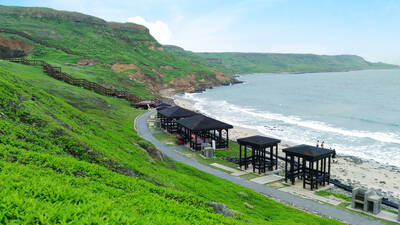While some set off rice bombs in reaction to changes in the agricultural sector since entry into the WTO, Changhua county has decided to meet those changes with a festival.
Tomorrow and Sunday, "Good Mountains, Good Water, Good Fun -- Changhua County Leisure Farm Festival" is scheduled be held at San Chun Lao Shu Leisure Farm (

PHOTO COURTESY OF CHANGHUA COUNTY AGRICULTURAL BUREAU
The festival "will let all of Taiwan see and experience what Changhua's leisure farms have to offer" said Hsu Hsiu-fang (
Since Taiwan joined the WTO in 2002, farms around the country have faced the problem of how to make money despite tough foreign competition. Many farms have incorporated tourism, allowing visitors to see and experience farm life through activities such as traditional tea ceremonies and fruit-picking.
Changhua, "the county of agriculture," has followed in the footsteps of counties such as Nantou, were the transformation to agricultural tourism began in the mid-1990s. The festival is a culmination of the county's efforts to develop and promote agricultural tourism.
According to Hsu, the festival is especially oriented around families with kids and elementary school classes. Adults will be able to relive the charms of childhood while youngsters will get a taste of farm life in a relaxed atmosphere.
The weekend's schedule is packed with group activities, such as tours and games with prizes, as well as do-it-yourself (DIY) hands-on activities, including plant cultivation and arts and crafts such as weaving, hat-making and fan-painting. The DIY activities are not free, but they are specially discounted for the festival.
Event notes:
What: Changhua County Leisure Farm Festival (好山好水好好玩∼彰化縣休閒農漁園區嘉年華)
When: Tomorrow and Sunday, from 10am to 5pm
Where: San Chun Lao Shu Leisure Farm, Huatan township, Changchun Villa, Youche Alley, No. 271 (彰化縣花壇鄉長春村油車巷271號)
Ticket: Fees for the DIY activities range from NT$30 to NT$100
Telephone: For schedules and information, call 02-2394-7676 or 04-722-2151 ext. 0662

On April 26, The Lancet published a letter from two doctors at Taichung-based China Medical University Hospital (CMUH) warning that “Taiwan’s Health Care System is on the Brink of Collapse.” The authors said that “Years of policy inaction and mismanagement of resources have led to the National Health Insurance system operating under unsustainable conditions.” The pushback was immediate. Errors in the paper were quickly identified and publicized, to discredit the authors (the hospital apologized). CNA reported that CMUH said the letter described Taiwan in 2021 as having 62 nurses per 10,000 people, when the correct number was 78 nurses per 10,000

As Donald Trump’s executive order in March led to the shuttering of Voice of America (VOA) — the global broadcaster whose roots date back to the fight against Nazi propaganda — he quickly attracted support from figures not used to aligning themselves with any US administration. Trump had ordered the US Agency for Global Media, the federal agency that funds VOA and other groups promoting independent journalism overseas, to be “eliminated to the maximum extent consistent with applicable law.” The decision suddenly halted programming in 49 languages to more than 425 million people. In Moscow, Margarita Simonyan, the hardline editor-in-chief of the

Six weeks before I embarked on a research mission in Kyoto, I was sitting alone at a bar counter in Melbourne. Next to me, a woman was bragging loudly to a friend: She, too, was heading to Kyoto, I quickly discerned. Except her trip was in four months. And she’d just pulled an all-nighter booking restaurant reservations. As I snooped on the conversation, I broke out in a sweat, panicking because I’d yet to secure a single table. Then I remembered: Eating well in Japan is absolutely not something to lose sleep over. It’s true that the best-known institutions book up faster

Though the total area of Penghu isn’t that large, exploring all of it — including its numerous outlying islands — could easily take a couple of weeks. The most remote township accessible by road from Magong City (馬公市) is Siyu (西嶼鄉), and this place alone deserves at least two days to fully appreciate. Whether it’s beaches, architecture, museums, snacks, sunrises or sunsets that attract you, Siyu has something for everyone. Though only 5km from Magong by sea, no ferry service currently exists and it must be reached by a long circuitous route around the main island of Penghu, with the